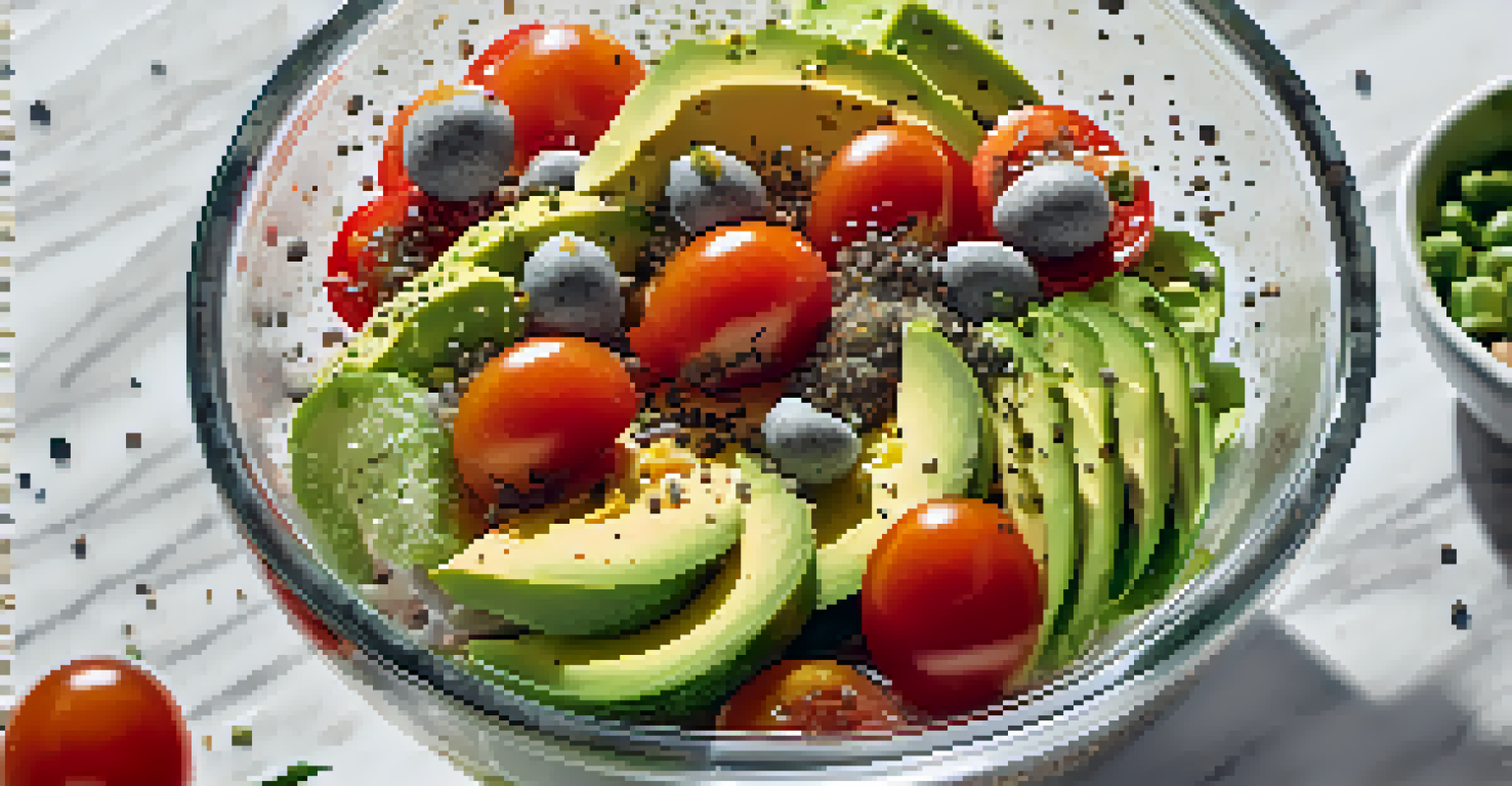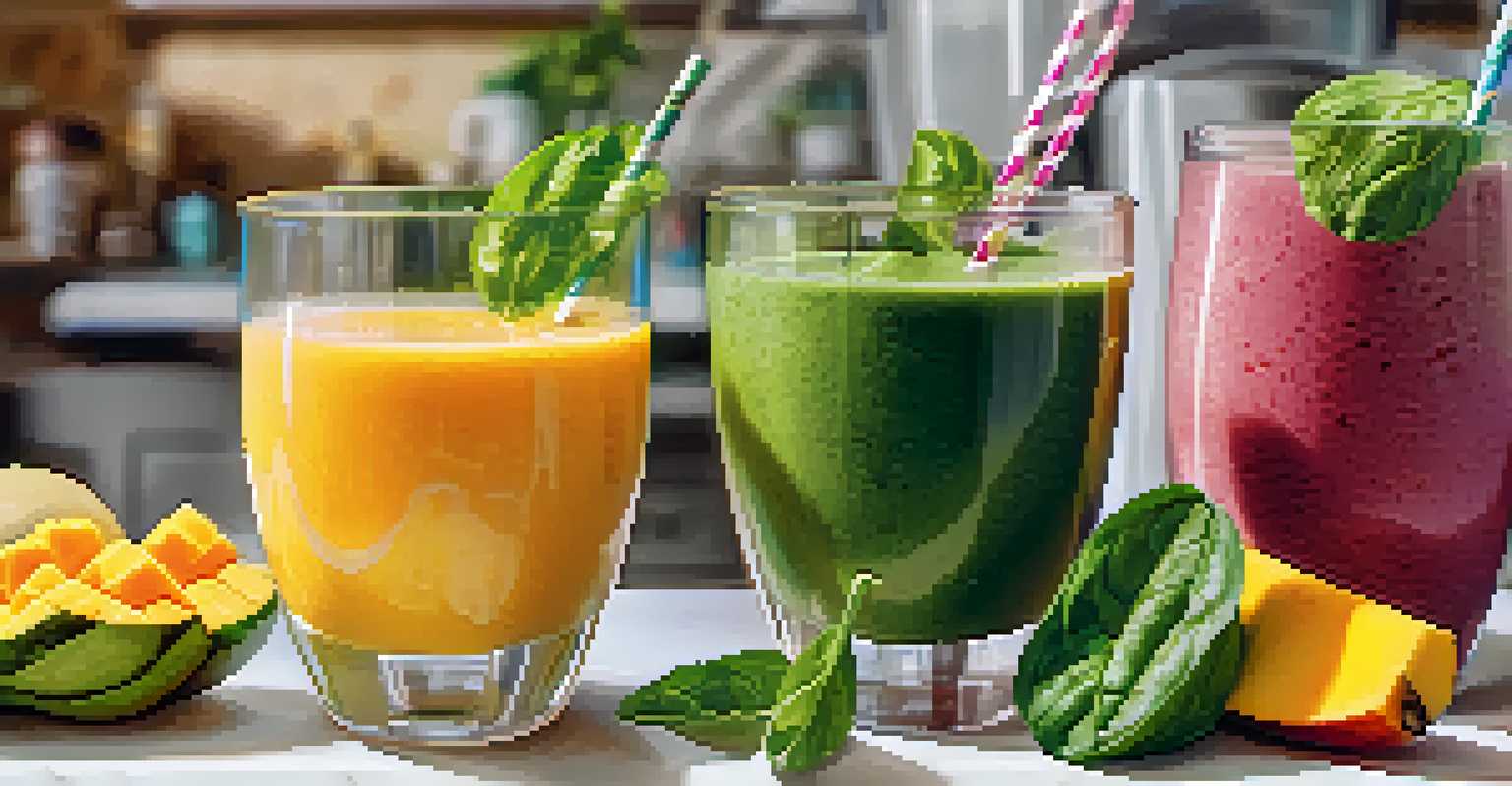How to Maximize Nutrient Density in Raw Food Preparation

Understanding Nutrient Density in Raw Foods
Nutrient density refers to the amount of essential nutrients a food contains relative to its calorie count. In the realm of raw food, this concept is particularly important because it emphasizes the health benefits of whole, unprocessed ingredients. By focusing on nutrient-dense foods, you can ensure your meals are not only filling but also packed with vitamins, minerals, and antioxidants.
Let food be thy medicine and medicine be thy food.
For instance, leafy greens like kale and spinach are considered nutrient-dense due to their high levels of vitamins A, C, and K, alongside minerals like iron and calcium. In contrast, a calorie-dense food like a processed snack might offer little nutritional benefit, making it vital to choose whole foods that contribute positively to your health. Thus, understanding nutrient density helps you make better choices for your raw food preparation.
Ultimately, embracing nutrient density can transform your raw food meals into powerhouses of nutrition. This understanding sets the foundation for maximizing the benefits of what you consume, leading to improved health outcomes and overall well-being.
Selecting the Right Ingredients for Raw Meals
The first step in maximizing nutrient density is selecting high-quality ingredients. Organic fruits and vegetables are often better choices, as they tend to have higher nutrient levels and fewer harmful pesticides. Look for seasonal produce, as it is usually fresher, tastier, and more nutrient-rich than out-of-season options.

Incorporating a variety of colors in your meals is another effective strategy. Different colors often represent different nutrients; for example, red bell peppers are high in vitamin C, while purple eggplants provide antioxidants. This colorful approach not only enhances the visual appeal of your dishes but also ensures a broader spectrum of nutrients.
Focus on Nutrient-Dense Foods
Choosing whole, unprocessed ingredients ensures meals are rich in essential nutrients while providing health benefits.
Finally, consider including superfoods in your raw food preparation. Ingredients like chia seeds, spirulina, and goji berries boast exceptionally high nutrient profiles, making them excellent additions to smoothies, salads, and snacks. By prioritizing quality and diversity in your ingredient selection, you can significantly boost the nutrient density of your meals.
Using Minimal Processing Techniques
Minimizing food processing is crucial for preserving the nutrient density of raw ingredients. Techniques such as soaking, sprouting, or dehydrating can enhance nutrient availability without cooking. For example, soaking nuts and seeds can increase their nutrient absorption and reduce anti-nutrients that inhibit digestion.
You are what you eat, so don’t be fast, cheap, easy, or fake.
When preparing raw foods, consider methods like blending or juicing, which can help break down cell walls and make nutrients more accessible. However, be mindful to consume the fiber-rich pulp to retain the beneficial components of the fruits and vegetables. This balance of processing can elevate the nutrient density of your meals while maintaining the raw integrity of the food.
Additionally, using kitchen tools like a mandoline or spiralizer can help you create visually appealing dishes while ensuring you retain maximum nutrients. These techniques not only make your meals more enjoyable to eat but also help you appreciate the natural flavors of your ingredients.
Balancing Macronutrients for Optimal Nutrition
While focusing on nutrient density, it's essential to also consider the balance of macronutrients: carbohydrates, proteins, and fats. Raw foods often lean heavily on carbohydrates from fruits and vegetables, but incorporating healthy fats from sources like avocados, nuts, and seeds can enhance satiety and overall nutrition. This balance fosters a well-rounded diet that supports sustained energy levels.
Incorporating plant-based proteins, such as legumes and sprouted grains, can further enhance your nutrient density. These foods not only provide essential amino acids but also contribute to a variety of vitamins and minerals. For instance, adding hemp seeds or nutritional yeast to dishes can pack a protein punch while enriching the flavor.
Incorporate Variety and Color
Using a diverse range of colorful ingredients not only enhances visual appeal but also ensures a broader spectrum of nutrients.
By crafting meals that balance these macronutrients, you create a more satisfying eating experience that fuels your body effectively. This approach ensures that you are not only maximizing nutrient density but also enjoying your meals to the fullest.
Incorporating Fermented Foods for Gut Health
Fermented foods play a vital role in maximizing nutrient density, particularly for gut health. Items like sauerkraut, kimchi, and raw sauerkraut are rich in probiotics, which support a healthy digestive system. A thriving gut microbiome can enhance nutrient absorption, making the nutrients you consume even more accessible to your body.
Additionally, fermentation can increase the bioavailability of certain nutrients. For example, fermenting grains can reduce anti-nutrients and enhance the levels of B vitamins. By including fermented foods in your raw meal preparation, you not only boost nutrient density but also promote overall gut health.
Incorporating these foods can be as simple as adding a side of kimchi to your salads or blending a splash of kombucha into your smoothies. This small addition can make a significant difference in the nutritional profile of your meals while introducing exciting flavors and textures.
Mindful Eating and Portion Control
Maximizing nutrient density is not just about what you eat, but also how you eat. Mindful eating involves paying attention to your food, savoring each bite, and recognizing your body's hunger cues. This practice can enhance your relationship with food, leading to more satisfying meals and better nutrient absorption.
Portion control is another essential aspect of mindful eating. Even the most nutrient-dense foods can contribute to weight gain if consumed in excessive amounts. By serving smaller portions and listening to your body's signals, you can enjoy the benefits of nutrient-rich foods without overindulging.
Practice Mindful Eating Habits
Being mindful of portion sizes and savoring each bite can improve your relationship with food and enhance nutrient absorption.
Ultimately, adopting a mindful approach can enhance your overall dining experience, making it more enjoyable and fulfilling. This can lead to better health outcomes and a deeper appreciation for the nourishing foods you choose.
Experimenting with Raw Recipes for Variety
To keep your raw meals interesting, experimenting with a variety of recipes is key. Trying new combinations of fruits, vegetables, nuts, and seeds can introduce exciting flavors and textures while maximizing nutrient density. For example, blending a tropical smoothie with spinach, mango, and coconut water can create a refreshing, nutrient-packed treat.
Incorporating raw food recipes from different cuisines can also bring variety to your meals. Dishes like raw zucchini noodles with a cashew-based pesto or a refreshing watermelon salad can make healthy eating feel vibrant and enjoyable. This culinary exploration can inspire creativity and keep your palate engaged.

Moreover, involving family or friends in your raw food preparation can make the experience more fun and social. Hosting a raw food potluck or cooking session can introduce new ideas and foster a community around healthy eating, ultimately enhancing your commitment to maximizing nutrient density.